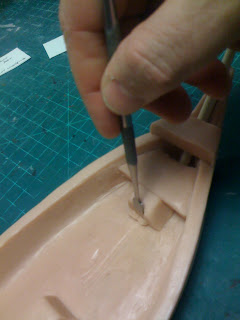Creating the forecastle.
In part two, I showed you how to add the stern and how to prepare the quarterdeck section for the removeable quarterdeck.
In this installment, I will step you through the process of adding the forecastle, bowspar, creating the removeable quarterdeck and finsihing up with the post support for the main mast.
As in part 1 & 2 you will begin with a completed picture of the pirate ship that this will be outlined in part 3.
Cutting the forecastle deck pattern:
You may find that this piece does not fit the bow area perfectly. The extra thickness will allow you to mold it into the area, creating a forecastle deck area large enought for one of two 25mm figures.
=> You will note in later pictures, I often use a "test" figure to help keep the model in perspective. I also use a 1:72 scale deck gun, to help align the gun ports.
Place the forecastle deck:
=> The deck should be slightly below the edge of the ship gunwale/side.
=> Optional: I will often add a bulkhead door, below the forecastle deck, assuming the deck is thick enought. With this ship however, I have not added this feature, since I have added the foremast support in this location instead. If you would like to add a door, just make your forecastle deck an extra 3/4 inch wide and insert the bow support on top of the forecastle deck.
Adding the bow spar:
Insert the bow spar along the prow, and push the end at least 1/2 inch into the clay of the forecastle deck.
Installing a Spar deck: 
Cut a small elongated trapezoid shaped deck, approximately 1/2 inch in thickness and about 3/4 inch wide.
This small spar deck will allow you to place a forward lookout, while providing the much needed support for the bow spar.
Installing the foremast support:
This is going to support the foremast, so it must be at least 3/4 inch square, and about 3/4 to an 1 inch thick.
=> Bigger is not always better, so keep the post reasonable sized. We are going to add wood later to help strengthen this piece.
Tool the foremast support:
Use a flat, square ended tool to secure and bond the piece to the main deck.Then blend the piece into the bulkhead of the forecastle deck. Try to keep the support piece larger at the base.
Again, we will add wood supports to this piece later, however make sure you keep the piece large enough to have a 5/16 inch doll rod inserted for the foremast.
Cutting the Quarter Deck and bulkhead:
Flatten a piece of clay, keeping the thickness about 1/2 inch. Make this piece large enough to not only cut to the two pieces show, but also enough to cut two additional side pieces.The main deck is a trapezoid shown above, with the bulkhead below, marked in the picture as the "Qtr Deck face". You will notice my pattern is too small. This is in part, is because my ship is wider then the sloop/schooner pattern I used to cut the main deck. Also in part, since as you tool, flatten and work the clay, it tends to stretch. This is ok, since the extra main deck space is useful if you plan to use the ship with figures for gaming.
Building the removeable quarterdeck:
Keep the deck at a nice 90 degree angle to the bulkhead face, working the clay seam to ensure a nice clean fit.
Also blend the outside seam on the face of the bulkhead, to ensure a nice smooth finish.
Cut the side bulkheads:
The sides will be placed with the quarterdeck face down on the work surface. Use your tools to blend the seam, both inside and outside.
Add a bead of clay inside:

This will help bond all the seams. Notice that I have added a bead of clay on both the horizontal and vertical seams.
Use your tools to blend the bead into the deck and bulkhead surfaces.
Install the removeable Quarterdeck:
The seam between the stern, quarterdeck piece and the removebale quarterdeck should be flush. It does not however need to be a tight fit, since this deck needs to remain independant of the rest of ship.
As we work details into the ship, this piece will be removed and installed several times. You may notice that I have belvel cut the two front corners of the piece. This is done to allow the steps to be placed, and it also forms a "key" type match of the removeable quarterdeck onto the ship deck. Once the steps are build, I had to make many adjustments to ensure the correct fit. If the "key" shape of teh belved deck and steps do not fit properly, the removeable deck will not be removeable.
=> I would suggest to keep the face of your removeable quarterdeck piece flat. It will make it easier to fit the removeable pieces later. The belve looks great, yet it can be a trouble area that can be easiliy avoided.
Installing the Main mast support:
 Make a ball of clay, a little smaller than a golf ball. Then cut out a 1 inch thick trapezoid shaped support post. Notice that the post is wider at the top and larger at the bottom.
Make a ball of clay, a little smaller than a golf ball. Then cut out a 1 inch thick trapezoid shaped support post. Notice that the post is wider at the top and larger at the bottom.Also I have made this support post about 1-1/2 inches wide by about 1 inch depth, by at least 1 inch tall at teh base.
This support post is going to be for the main mast, and later I will show you how to add wood support to help strengthen the support piece.
Tooling the Main mast support:
Use the center lines on the main deck to help place the support post in the correct location.
Use a flat, square edged tool to blend the clay from the post onto the main deck. I have not added a bead, however if you need a bead do so to help blend the post to the deck. This piece needs to be strong, since it will support the main mast, which will be removed and placed many times over the life of the model.
=> Again, later I will show how to add extra wood to support this piece, yet the clay alone should be strong enough to support the main mast.
Concluding part 3:
- This will conclude Step THREE of how to build a pirate ship by hand. Below you can see that the model is finally taking shape and starting to look like a ship. The grid lines on my work surface are 1/2 inch squares. So you can see that the ship is 13 inches bow to stern, plus 3-1/2 inches of bow spar extension at the prow. Once you place the rudder this ship will measure 17 inches by about 6-1/2 inches at the widest point. By approxiamte scale, this would make our ship about a 100 to 110 foot in length. Not bad for a fast and manuverable pirate ship.

In the next installment, I will demostrate how to add the gun ports and how to add steps that lead up from the main deck to the quaterdeck.
- By the way, if at any point you need a few extra tips on the build, drop me a line or post comment and I will address your questions. The purpose of this tutorial is for YOU to learn the steps needed to create your own pirate ship. As with any instruction, when in doubt, just ask a question.
John T Cusack










No comments:
Post a Comment